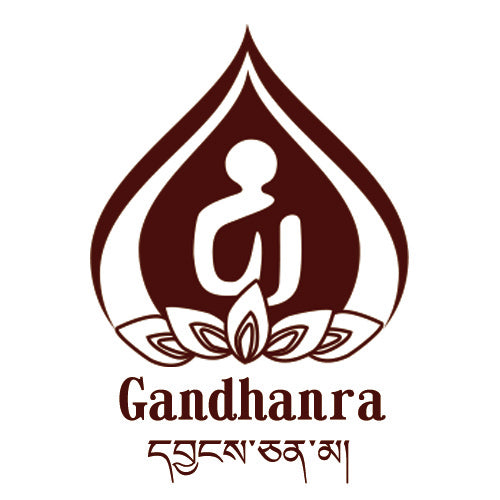
Tibetan Treasure Box: The Gau Box in Himalayan Art
Interested in our Gau crafts?
Please click on the link - Gau Box.
ནོར་བུ་གའུར་བཅུག་ཡོད།
གའུའི་བདག་པོ་ང་ཡིན།
Small box of treasures
I am the master of the treasure box
(Tibetan proverb)
"Ga'u Box with Four Corners of Amitayus Buddha"
-20th century, Nepal, private collection.
This type of Ga'u box (for females) is known for its unique variety and form of jewelry decoration. It is commonly found in Nepal and the Himalayan region, sometimes with a main deity inside the box. Ga'u boxes from the late 19th century in Tibet have been greatly influenced by this style.
This Buddha shrine style Ga'u box is the most common type found in Tibetan areas, also known as "temple-style" or "palace-style". These shrine style Ga'u boxes are often used for worship or for carrying (by males).
"Golden Lotus Gem-Inlaid Treasure Gau Box," 18th century,
Basel Museum of Culture
The main deity in this Gau box is in the style of Tsatsa.
This is one of the four common styles of inner contents found in portable Gau boxes.
The other three styles are:
Mantra - Nectar pills - Amulets
"Silver and Turquoise Gau Ornament," 19th century,
University of Michigan Museum of Anthropology
Aside from being used for religious purposes,
Gau is also a common accessory for men and women in Tibetan areas.
The Gau in the image belongs to the "hair ornament" (སྐྲ་གའུ་) category,
serving as a topknot ornament for men
often carrying specific symbolic and spiritual significance.
"Silver and Turquoise Eight-Sided Gau Ornament," 19th century,
University of Michigan Museum of Anthropology
This type of eight-sided Gau ornament (གའུ་ཟུར་བརྒྱད་མ་)
is worn as a chest ornament by women,
also known as a "mandala-style Gau Box."
"Square Guan Gong Gau Box," 19th century,
Jacques Marché Tibetan Art Museum
Guan Gong is known as Lord Yun Chang in Tibetan Buddhism,
with belief mainly concentrated in Northern Asia and Central China regions.
This Guan Gong Gau box exhibits a common style in Northern Asia.

The main deity in this Gau box is in the form of Sakya King.
This Gau box, with a history of over two hundred years,
eventually came into the possession of a follower of the Sakya sect
through elaborate welcoming rituals,
allowing the Gau box to be passed down through generations.
In the winter of 1757 AD, after years of dedicated practice, the Nyingma sect high lama Jinme Linba (འཇིགས་མེད་གླིང་པ་; 1730-1798) was bestowed a Gau box by the Dakini. According to records from Jinme Linba's biography: this finely crafted Gau box had a strong camphor smell, and inside were five scrolls of yellow paper containing teachings from the "hidden treasures." In Tibetan scriptures, there are numerous descriptions of Gau boxes like this one. For the people in the "Himalayas-Tibet" region, Gau boxes are not only ornaments symbolizing status and identity, but also special heirlooms and spiritual tools in religious culture.

18th century, The Rubin Museum of Art in New York.

"Gampopa Master,"
18th century, Rubin Museum of Art, New York
"When the master Gampopa (སྒམ་པོ་པ་; 1079-1153) passed away, his students placed fragments of his robes in a Gau box to demonstrate the authority of the lineage of teachings."
In the Tibetan context, the Gau box (གའུ་) means "small box," also known as "sealed box" (གའུ་ཁ་སྦྱར་) and "sacred box" (ཟ་མ་ཏོག་). The first term describes the form of the Gau box, while the latter points to its excellence. There have been various interpretations of the origin of the Gau box. In local culture, the Gau box is a protective box for the soul and body (the early form of the protective box should be the core origin of the Gau box). The material and decorations of the Gau box have specific sacred meanings, such as turquoise as a "soul stone" and commonly seen auspicious symbols. During the Tubo period, similar decorations to the "Gau box" became symbols of power hierarchy. With the introduction of Buddhism, the Gau box also incorporated Buddhist elements. In the "Five Sections of the Treasure Teachings" (བཀའ་ཐང་སྡེ་ལྔ་), there is a record of a Tubo emperor offering a Gau box to Lotus-born Guru Rinpoche (questionable record).

"The Wrathful Yamantaka Gau Box,"
19th century, private collection

"Different Main Deity Gau Boxes,"
18-19th century, private collection

"Different Main Deity Gau Boxes"
18th century, private collection
The development of the Gau box (and Gau jewelry) has gradually evolved into two different paths since the time of the Great Tibetan Renaissance: the religious aspect and the secular aspect. For practitioners, the Gau box is not only a portable shrine, but also a sacred object to receive blessings from the main deity (praying for the protection of the gods). As the variety of offerings inside the Gau box continues to increase, its symbolism in different contexts also varies. Although Gau jewelry is one of the important accessories in Tibetan areas, it was not until the two "revival movements" in the 14th and 17th centuries (referring to the movements of the Panchen and Dalai Lama to integrate political order in a retro way) that Gau jewelry finally took on the appearance we see today.

"Gold-inlaid precious gemstone Buddha shrine-style Gau box"
17th century, private collection

"Turquoise-inlaid octagonal Gau jewelry"
19th century,Royal Ontario Museum

"Copper square Gau box"
19th century,University of Michigan Museum of Anthropology
The offerings inside this Gau box are quite abundant:
Vajravarahi - amulet - seed syllable

"Different offerings in Gau boxes"
18-19th century, private collection.

"The Silver Bottom Victory Banner Design Ga'u Box"
18th century, private collection
The "Victory Banner" (རྒྱལ་མཚན་) is one of the Eight Auspicious Symbols

"The Silver Bottom Jeweled Tsongkhapa Ga'u Box"
18th century, private collection
Decorated with the Eight Auspicious Symbols around the edges

Detail: Buddha niche inside
Bottom features the "Double Deer Turning Wheel" design


"The Gold Bottom Kartika Style Ga'u Box" interior
20th century, Nepal, private collection








